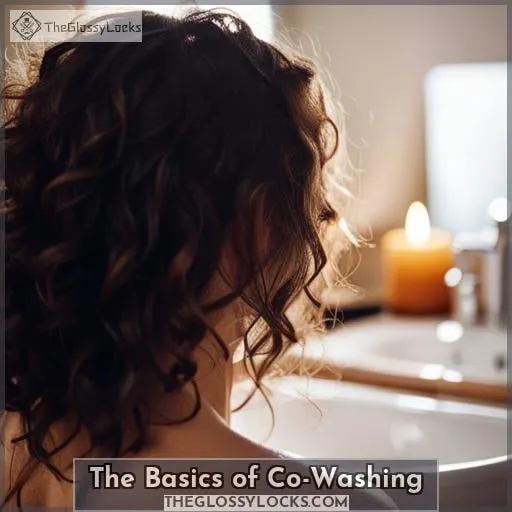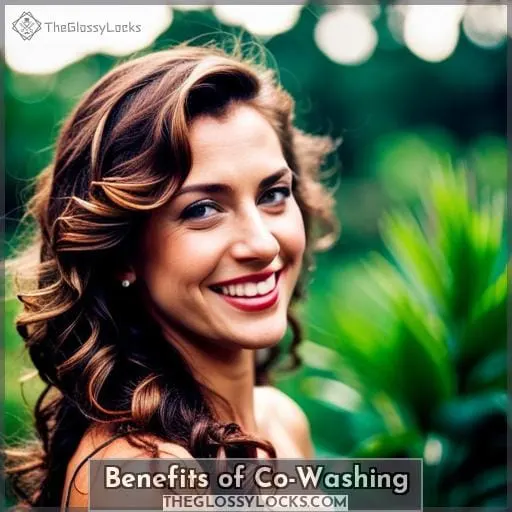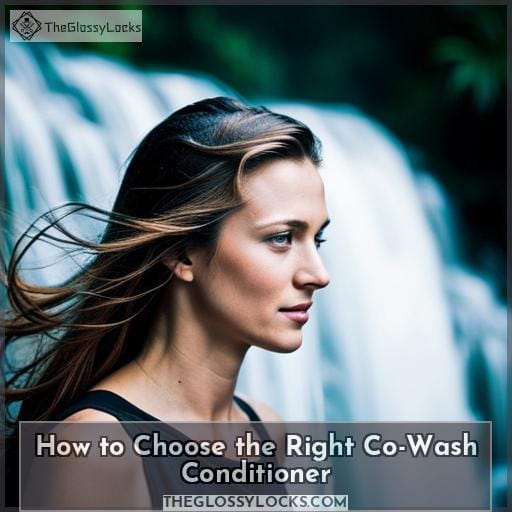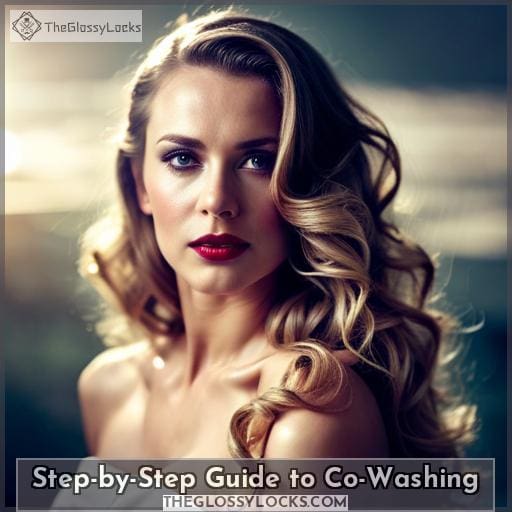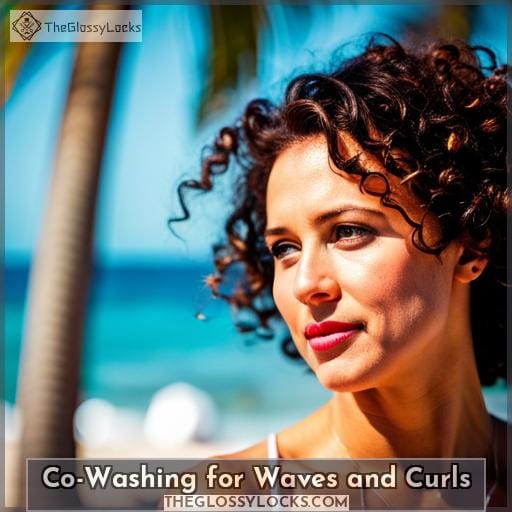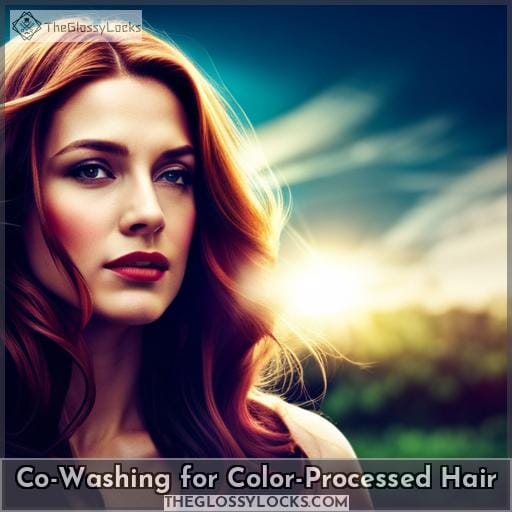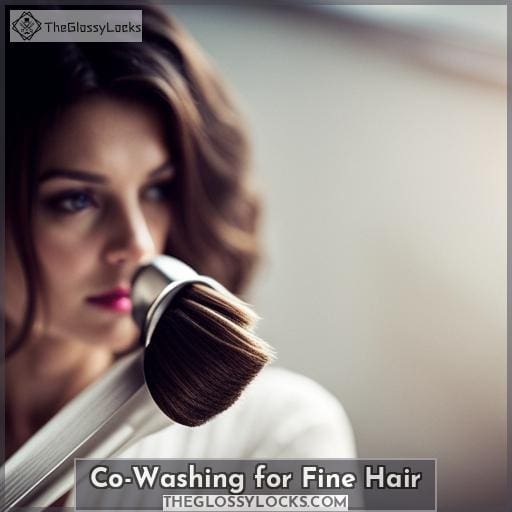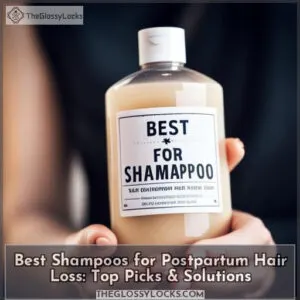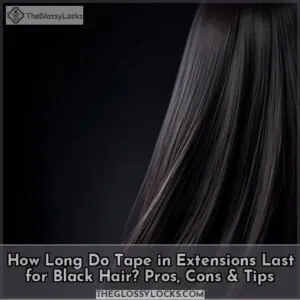This site is supported by our readers. We may earn a commission, at no cost to you, if you purchase through links.
 Are you looking for a way to give your hair the moisture it needs without stripping away its natural oils? Co-washing might just be the answer.
Are you looking for a way to give your hair the moisture it needs without stripping away its natural oils? Co-washing might just be the answer.
In this article, we’ll discuss what makes co-washing so beneficial. We’ll also explore who should try it out and how to choose the right product for you. Additionally, we’ll provide step-by-step instructions on how best to use co-washing.
Table Of Contents
Key Takeaways
- Co-washing is a method of hair care that uses conditioner instead of shampoo to cleanse the scalp.
- It is popular among people with curly, coily, and color-processed hair.
- It helps maintain moisture levels and prevents the stripping of natural oils.
- Co-washing leaves hair softer, smoother, and easier to manage.
The Basics of Co-Washing
If you have curly or coily hair, try the hydrating and moisturizing benefits of co-washing today – it’ll leave your strands softer, smoother, and easier to manage! Co-washing is a simple way to cleanse your scalp without using shampoo.
It involves applying conditioner directly onto the scalp in place of shampoo and then rinsing out.
Conditioners hydrate and moisturize hair instead of stripping away its natural oils like shampoos do. This method can help maintain moisture levels in your curls so that they look healthier for longer periods of time.
However, there are some pros and cons as well as mistakes to avoid when it comes to this technique; understanding these will ensure that you get maximum results from co-washing while avoiding any potential issues such as buildup on the scalp or product residue left behind on strands.
Understanding how often you should be washing with conditioner versus regular shampoo is also important; alternating between both methods every 7–10 days will provide balance for optimal results without leading to dryness or other problems associated with overuse of one type over another.
Additionally, finding products specifically designed for use during a co-wash (such as those containing emollients, proteins, and humectants) will make sure that all benefits are maximized while minimizing any risks associated with incorrect usage.
Who Should Co-Wash?
Co-washing is a popular method of hair care that has been gaining traction in recent years. It can be beneficial for some, but not all hair types. Ideal hair types include dry, curly, and wavy strands, as well as color-processed tresses.
However, fine straight locks or those with oily scalps should avoid co-washing entirely to prevent scalp issues from occurring.
Ideal Hair Types
Discover the perfect co-washing solution for your hair type – whether it’s curly, coarse, or fine. Textured hair requires different conditioning than straight strands, and co-washing can help maintain natural moisture levels in the hair.
Choosing conditioner is key when opting for a co-wash routine. Look for ingredients such as emollients, proteins, humectants, and moisturizers that will nourish your locks without stripping away essential oils and nutrients.
For those with curls or waves, consider leaving the conditioner on longer. Finer-haired individuals may require something lighter, like an ultra-light formula that won’t weigh down their tresses too much.
Co-washing has many benefits, including smoother locks that are easier to manage and time-saving when it comes to showering. With its hydrating properties, you can avoid harsh shampoos containing sulfates and enjoy healthier-looking tresses with each wash day.
Hair Types to Avoid Co-Washing
People with fine, straight hair, oily scalps, or dermatitis should steer clear of co-washing in order to avoid scalp issues.
Hair types that don’t benefit from co-washing include:
- Fine hair – this type may require a lightweight conditioner that won’t strip natural oils.
- Color-processed hair – as shampoos can strip strands of pigment and moisture, it’s best to opt for an alternative cleansing method such as cleansing conditioners.
- Oily scalp – those with oilier scalps may need more frequent shampooing than usual to prevent buildup and maintain natural balance on the scalp.
For people who fall into any of these categories but still want hydration benefits without stripping their locks dry, there are plenty of other alternatives available for maintaining healthy tresses. These alternatives include deep conditioning treatments or using sulfate-free shampoos less frequently than traditional wash methods would suggest.
Benefits of Co-Washing
If you have curly hair, co-washing is an effective way to keep your locks hydrated and healthy. By using the right conditioner for your hair type, you can benefit from the moisture retention that comes with this washing method without compromising cleanliness or causing buildup.
Co-washing for curly hair
Curly hair types will benefit from a richer co-wash to maintain their natural moisture levels and keep curls looking bouncy and hydrated. The Science Behind Co Washing helps to nourish the hair with emollients, proteins, humectants, and moisturizers.
Techniques for Co Washing Curly Hair ensure that all of the product is evenly distributed throughout strands.
A deep conditioning treatment every 7-10 days, in addition to regular shampooing, can help rehydrate the scalp while protecting it from buildup. This routine allows you to access The Benefits of Co Washing for Natural Hair without compromising its health or texture.
Benefits of moisture retention
By co-washing, you can maintain natural moisture levels in your hair while avoiding the harsh stripping of oils and moisture that shampooing with sulfates can cause. With regular use, your strands will be softer and healthier due to improved hydration benefits from conditioners.
Retaining moisture is essential for healthy hair as it prevents breakage and helps seal split ends. It also creates a protective layer over each strand, making them more resistant to damage from styling tools or environmental factors like sun exposure or windy days.
Co-washing not only keeps the locks moisturized but also adds manageability, making it easier to style without frizziness or tangles!
Finding the right conditioner
Finding the right conditioner for your co-washing routine can be tricky, but it pays off in softer, smoother hair! Look for natural ingredients like emollients and proteins that help retain moisture. Avoid silicones as they can lead to buildup over time. Different hair types require different products – lightweight options are better suited to fine strands, while thicker locks may need a richer product.
Experiment with timing too – leave the conditioner on longer if you have curly or coarse hair.
How to Choose the Right Co-Wash Conditioner
When it comes to co-washing, choosing the right conditioner can make all the difference. It’s important to avoid ingredients such as silicones and sulfates, which strip natural oils from hair strands. Additionally, selecting a product that matches your specific hair type is essential for achieving desired results.
Balancing out regular shampooing with co-washing every 7 to 10 days will help maintain optimal scalp health and moisture levels in your locks.
Ingredients to Avoid
When shopping for a co-wash conditioner, it’s important to avoid ingredients like sulfates and silicones that can strip natural oils from your hair. Look out for cationic surfactants which act as detergents but don’t dry or damage the hair.
Your ideal choice should also be free of harmful chemicals such as parabens, dyes, and sodium lauryl sulfate. Moisturizing properties are key, so opt for emollients, proteins, and humectants in your formula to keep curls hydrated without buildup leading to contact dermatitis or an itchy scalp.
Try an avocado co-wash with lightweight benefits if you have fine strands – this will still give detangling benefits while avoiding weighing down tresses too much! Sulfate-free formulas provide cleansing power while protecting against drying effects; choose these over heavy conditioning creams if you find yourself needing more volume between washes!
Matching Hair Types
It’s important to choose the right co-wash conditioner for your hair type, like a key unlocking its perfect fit. When selecting products, it’s best to consider your natural texture and common issues such as buildup or dryness that you may experience.
For thick, curly, or coily hair types, look for heavier formulas with emollients and proteins that can help detangle strands without stripping away moisture.
Those with fine, straight hair should opt for lightweight cleansers that won’t weigh down locks but still provide hydration.
Co-washing mistakes can be avoided by balancing shampooing every 7-10 days. This will keep scalp health in check while achieving healthier-looking tresses!
Balancing with Shampoo
To maintain healthy hair, balance your co-washing routine with regular shampooing every 7 to 10 days. Co-washing can be great for those looking for an extra boost of shine and moisture, but it’s important not to overdo it.
Alternating between the two will help keep scalp issues at bay while still enjoying all the benefits that come from co-washing.
For people with oily scalps, frequent use of a clarifying shampoo may be necessary to prevent buildup on the scalp, which can lead to itching or contact dermatitis. It’s also essential to choose a conditioner suitable for co-wash purposes that doesn’t contain silicones.
This will ensure that natural oils are not stripped away from the hair strands during the rinsing off process.
In order to ensure proper care and optimal results, take time to find out what works best for your individual needs.
Step-by-Step Guide to Co-Washing
Follow these steps and you’ll be co-washing like a pro in no time, with locks as soft and smooth as silk. Co-washing is the perfect way to get beautiful hair without stripping away natural oils or drying out strands.
Start by finding the right conditioner for your hair type. Look for emollients, proteins, humectants, and moisturizers that will help keep moisture locked in while cleansing gently.
Lather up with conditioner from root to tip before massaging into the scalp thoroughly. Leave it on for three minutes or longer if you have curly or coarse hair. Then rinse off completely until all traces of product are gone.
Every 7 to 10 days, substitute regular shampooing instead of co-washing. This helps prevent issues such as buildup, which can lead to contact dermatitis and an itchy scalp. Alternating between both methods ensures that dirt doesn’t accumulate while still maintaining the natural oils necessary for softer tresses.
Experiment with different products until you find one suitable. Top picks include Afrocenchix Swirl Silicone-Free Conditioner, Pantene Gold Series Deep Hydrating Co Wash, Shea Moisture Curl Moisture Co Wash, Live Clean Apple Cider Ultra Light Conditioner, Lush Avocado Cowash, and Lush Happy Happy Joy Joy.
Finally, take advantage of all the benefits: fewer showers needed due to less buildup, plus easier-to-manage locks!
Co-Washing for Waves and Curls
For those with waves and curls, co-washing can be a game changer. It helps restore moisture levels, leaving hair softer and easier to manage. An effective co-wash routine begins with finding the right product for your hair type.
Conditioners for wavy or curly hair should contain natural ingredients such as emollients, proteins, humectants, and moisturizers. These ingredients help hydrate strands without stripping them of their natural oils.
When washing your locks in this manner, you want to massage the conditioner into your scalp before rinsing thoroughly.
Fine hairs will require lightweight formulas, while thicker ones will benefit from more nourishing options. Experiment until you find what works best for you. As an added bonus to all these benefits, using this method instead of shampoo every time saves both time (no waiting!) and money (one less bottle!).
So go ahead and give it a try today – we promise it won’t disappoint!
Co-Washing for Color-Processed Hair
Swinging your hair around like a sassy diva while preserving your color-processed locks? Co-washing is for you! Whether you’re rocking box braids, balayage highlights, or have just had a full head of dye, co-washing can help maintain the vibrancy and longevity of your color.
- Color Longevity – Co-washing helps protect against fading by avoiding harsh sulfates that strip away natural oils and moisture.
- Benefits – It hydrates strands with conditioner instead of shampoo, which cleanses without drying out hair.
- Protecting Hair Color – Conditioners contain trace amounts of detergents called cationic surfactants that pick up dirt when mixed with water—leaving it feeling clean but not stripped from essential nutrients and pigment.
- Frequency – Alternate between co-washing every 5–7 days and regular shampooing every 7–10 days to prevent scalp issues from buildup while still maintaining softness in colored tresses.
- Dye & Styling Products – Use clarifying shampoos once every two weeks to remove product residue/buildup, especially after styling products or frequent coloring services if necessary for second-day hair looks!
Overall, co-washing preserves dyed tresses’ vibrant hues so they stay looking fresh longer without compromising their natural healthiness!
Co-Washing for Fine Hair
Glide a lightweight conditioner through your fine hair to co-wash and keep natural oils intact. Co-washing is an effective way of maintaining the health and moisture levels in delicate, thin strands while preventing buildup.
Fine hair benefits from a gentle formula that won’t strip away its natural oils or add excess weight. Look for lightweight conditioners free of silicones, sulfates, parabens, and other harmful ingredients.
When it comes to co-washing frequency for finer textures, use caution as too much cleansing can lead to dryness or scalp irritation. Alternate between shampooing every 7-10 days with a clarifying shampoo once every two weeks depending on individual needs.
For maximum volume without weighing down strands with product buildup, try adding some mousse before blow-drying after each wash session.
Co-washing offers convenience when it comes to shower space without sacrificing hydration or cleanliness. It is suitable even for those with color-treated locks as well as straight hair types looking for added softening action minus any extra greasiness often associated with oil-based products.
Find the right combination of regular shampooing mixed in perfectly timed co-washes tailored specifically towards your unique texture today.
Maintaining Hair Health With Co-Washing
To maintain healthy hair, co-washing can be a great way to keep it hydrated and moisturized. Research shows that using conditioners between shampoo sessions helps seal in natural oils for up to three times longer than regular shampoos.
- Co Washing Benefits: Moisturizes hair, adds shine and softness, seals in natural oils.
- Co Washing Techniques: Massage conditioner into the scalp, distribute evenly through ends; let absorb for 3-5 minutes.
- Co Washing Myths: Doesn’t cause buildup if done correctly; use clarifying shampoo occasionally to remove residue buildups.
- Co Washing vs Shampooing: More hydrating; cleanses without stripping essential moisture from strands or removing pigment from color-treated hair.
Different types of hair require different approaches when it comes to washing them with a conditioning product such as a co-wash. Those with curly or coarse locks may benefit from leaving the formula on their head for an extended period, while those with finer tresses should opt for lightweight formulas instead of heavier ones, which could weigh down their delicate strands even further.
It is also important to remember that there isn’t one single type of product suitable for all individuals, so experimentation may be needed before finding what works best according to your individual needs and preferences.
Scalp health should still be monitored regularly, however, as too much cleansing agent (conditioner) might lead some people to develop scalp issues over time, despite its many benefits overall.
Conclusion
Co-washing offers a refreshing alternative to traditional shampooing for curly, coily, and wavy hair. It’s no wonder this method is becoming increasingly popular, with benefits such as increased moisture retention, ease of use, and cost savings.
Choosing the right conditioner for your hair type is important, as is balancing co-washing with regular shampooing to prevent scalp issues. With the right products and techniques, you can enjoy the healthy, glossy hair of your dreams.
Co-washing is a great way to keep your curls, coils, and waves looking their best.

